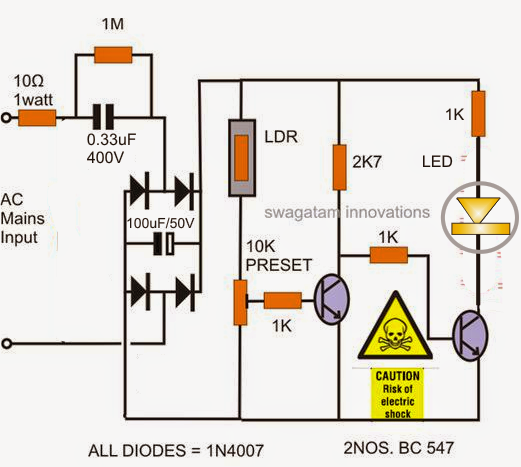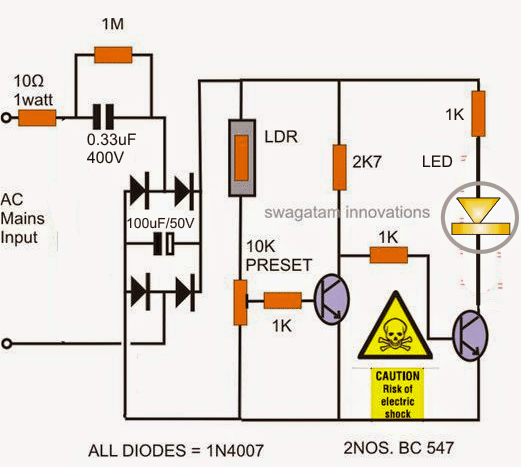The submit talks about a basic transformerless LED candle light circuit which switches ON automatically without the presence of ambient light in the room and vice versa.

The suggested automatic darkness activated candle light circuit can be viewed in the demonstrated diagram which utilizes an amber colored LED for simulating a candle light impact.
According to the demand the circuit ought to be LDR based which also means the unit must trigger as soon as it's adequately dark inside the room or the moment the main indoor lights are switched OFF, or when the user goes to bed.
The displayed automatic LED candle light is extremely uncomplicated and relatively dependable with its procedures, let's figure it out by means of the following justification:
The 0.33uF/400 V capacitor together with the four diodes and capacitor forms a portable transformerless power supply circuit stage for operating the LED during dark or without having ambient light.
The first transistor from left in the existence of ambient light circumstances obtains adequate base drive via the LDRs lower resistance and performs to maintain the base of the second BC547 at ground potentials.
As a result of this the second transistor continues to be inactive and switched OFF making certain that the associated LED also remains to be turned OFF under such ambient external illuminations.
Nevertheless whenever the ambient light around the LDR decreases or is shut OFF, the left transistor is inhibited from the base drive as a result of the LDRs high resistance without having ambient light, which additional encourages the right hand side transistor to begin carrying out, consequently activating the LED.
The opposite reaction is immediately shown in the event the ambient light is turned on or in the course of daybreak.
Caution: The circuit is not isolated from mains voltage, utmost care and precaution is predicted from the user wile putting together, examination, placing the unit in operated circumstance.
The LDR needs to be properly enclosed inside an appropriate cover such that the LED light by no means attains it under any specific situation, elsewhere it might result in false activating and oscillations of the circuit and the LED.
The publish represents an easy transformerless LED candle light circuit which switches ON automatically without the presence of ambient light in the room and vice versa.
The presented automatic darkness turned on candle light circuit can be watched in the presented diagram which employs an amber colored LED for simulating a candle light result.
In accordance with the inquiry the circuit is required to be LDR based which also means the unit must actuate only after it's properly dark inside the room or the moment the main indoor lights are switched OFF, or when the user goes to bed.
The displayed automatic LED candle light is quite simple and quite trustworthy with its functions, let's are aware of it by way of the following clarification:
The 0.33uF/400 V capacitor in addition to the four diodes and capacitor forms a lightweight transformerless power supply circuit stage for running the LED during dark or without any ambient light.
The first transistor from left in the occurrence of ambient light problems experiences enough base drive via the LDRs lower resistance and carries out to continue the base of the second BC547 at ground potentials.
Due to this fact the second transistor continues to be inactive and switched OFF ensuring that the hooked up LED also remains to be turned OFF under such ambient external illuminations.
In spite of this whenever the ambient light around the LDR reduces or is shut OFF, the left transistor is inhibited from the base drive on account of the LDRs high resistance without having ambient light, which even more guides the right hand side transistor to commence executing, and thus activating the LED.
The opposite reaction is instantly shown just in case the ambient light is activated or throughout daybreak.
Caution: The circuit is not isolated from mains voltage, utmost care and precaution are estimated from the user wile building, assessing, fitting the unit in driven condition.
The LDR ought to be correctly enclosed inside the right cover such that the LED light certainly not grows to it under almost any problem, normally it could produce false switching on and oscillations of the circuit and the LED.

Leave a Reply